Saffron is the most expensive spice in the world—and with good reasons.
Saffron is a spice of reddish-brown threads, also known as the “red gold” and “the queen of all spices.” It comes from the dried bright orange-red stigmas of the flower Crocus sativus.
Saffron has a long and colorful history. The use of Saffron dates back nearly 3000 years, spanning many continents, civilizations, and cultures.
Back in the Middle Ages, people used this thing as a medicine. Today, it is used in culinary applications to flavor dishes or as a natural yellow dye. Saffron is a common ingredient in Indian, Moroccan, and Iranian cuisines.
The Saffron market is poised to grow as consumers seek natural remedies, boosting demand for saffron-based products in nutraceuticals, skincare, and pharmaceuticals.
Saffron’s luxury status fuels demand further, driving new trends in 2024, such as environmentally sustainable and eco-friendly.
Current Saffron Market Scenario
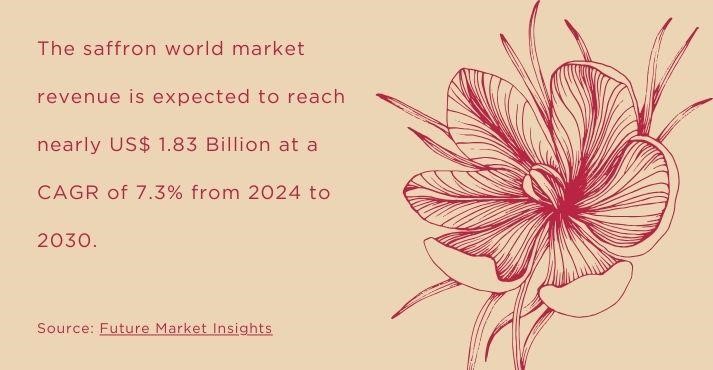
According to Future Market Insights, the global Saffronvalue has a current valuation of US$ 525.7 million in 2023.
The total Saffronworld market revenue is expected to grow at a CAGR of 7.3% from 2024 to 2030, reaching nearly US$ 1.83 Billion. The Saffron market performance has risen with a CAGR of 2.2% (2018 to 2022), likely surging by 3.0% by 2033.
The saffron market reflects dynamic growth driven by rising consumer demand for natural and premium ingredients. With its vibrant color and unique flavor, saffron finds applications in culinary, pharmaceuticals, and cosmetics.
As awareness of saffron’s health benefits grows, its popularity continues to rise, making it a sought-after spice.
Saffron Demand Drivers
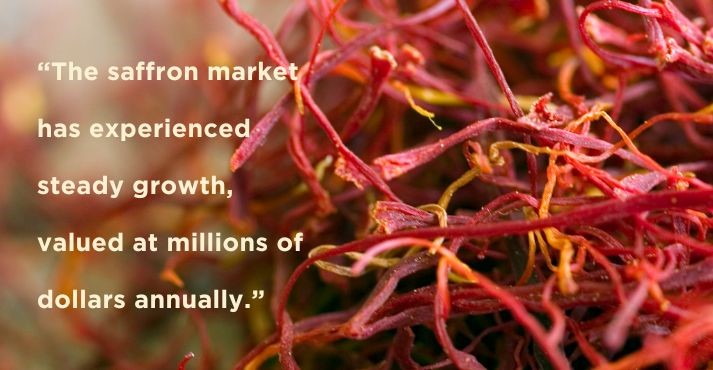
The increasing demand for Saffron is driven by its versatile culinary uses, perceived health benefits, and rising consumer awareness of its unique flavor and color.
As consumers prefer natural additives, Saffrongains traction as a food colorant, replacing synthetic alternatives—Saffron’s luxury status and cultural significance fuel demand as a premium commodity, especially on special occasions.
It appeals to individuals who value upscale culinary experiences due to its excellent flavor profile, vibrant hue, and long and distinguished history. The desire for exquisite luxury has significantly increased the demand for saffron.
Saffron is rich in compounds like crocin and safranal, which possess potent antioxidant effects. It has antidepressant properties and could help improve mood. Saffron may have cognitive-enhancing effects, potentially benefiting memory and overall cognitive function.
Saffron has gained popularity as a key ingredient in health beverages, teas, and supplements due to its potential health benefits, particularly its antioxidant properties.
Incorporating Saffronin into these products resonates with consumers who focus on their overall well-being and seek to enhance it through their dietary preferences.
Moreover, the increasing demand has led food manufacturers to introduce saffron-infused products like teas, supplements, and cosmetics, diversifying their applications.
Moreover, the increasing adoption of sustainable and urban farming practices boost Saffron cultivation.
This trend encourages environmentally friendly agricultural methods and ethical sourcing, aligning with the preferences of consumers who are actively seeking responsibly produced goods. This, in turn, contributes to the expansion of the Saffron market.
Challenges in Saffron Production
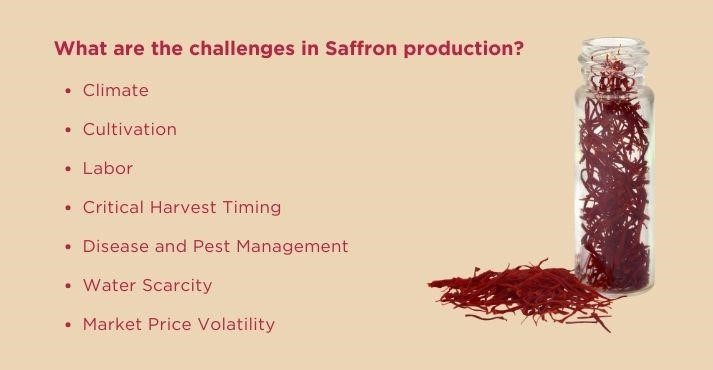
According to FAO, Iran is the largest producer of Saffron in the world and has over 90% of Saffron production worldwide. The production and supply of saffron are affected by climate, cultivation, labor issues, water scarcity, market price volatility, and disease management.
- Climate: Saffron cultivation is highly dependent on specific climatic conditions. Unpredictable weather patterns, such as temperature fluctuations and irregular rainfall, can impact Saffronyields, posing a challenge for consistent production.
- Cultivation: The labor-intensive nature of Saffron cultivation demands skilled workers, from planting to harvesting delicate flowers. Ensuring a skilled workforce is essential for maintaining the quality and quantity of Saffron production.
- Labor: Saffron harvesting requires meticulous handpicking of delicate stigmas, making it labor-intensive. Labor shortages or high labor costs can affect the timely harvesting of Saffron flowers, potentially impacting overall crop quality and yield.
- Critical Harvest Timing: The harvest period for saffron is remarkably brief, typically lasting only one to two weeks.
- Disease and Pest Management: Saffron crops like corm rot and spider mites are susceptible to diseases and pests. Effective management strategies are crucial to prevent yield losses and maintain the quality of saffron.
- Water Scarcity: Saffron is still grown as a rainfed crop; hence, it is vulnerable to scarcity/surplus of water. Water scarcity poses a significant challenge, impacting crop growth and potentially reducing Saffron production.
- Market Price Volatility: Saffron faces market price fluctuations due to factors like geopolitical events and economic conditions. This volatility can pose financial challenges for saffron.
The challenges faced by Saffron producers collectively impact the Saffron market. These factors can lead to yield variations, affecting the overall supply and potentially resulting in price fluctuations.
Quality maintenance and timely harvesting also become crucial, influencing consumer confidence. Addressing these challenges is essential for sustaining a stable and thriving Saffron market.
Innovations in Saffron Farming
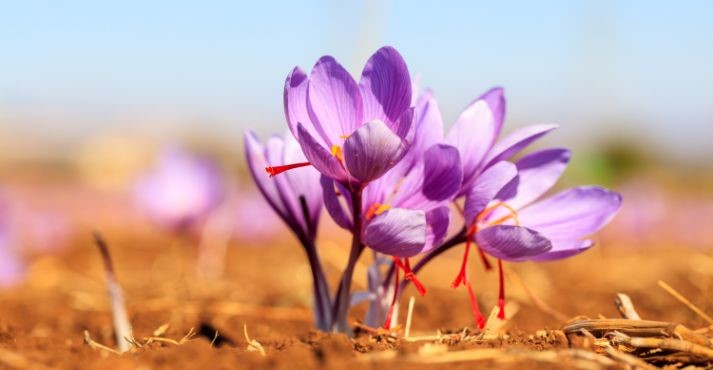
Saffron is traditionally a family farming crop grown on relatively small-scale farms based on yield sustainability, relying on locally available resources. But as agritech evolves, innovation in Saffron farming optimizes and enhances the cultivation of Saffron plants.
Utilizing advanced technologies like hydroponics, LED lighting, and precise climate control systems, indoor farming offers a more controlled and efficient approach to saffron production.
Here are some modern farming techniques for saffron production:
- Hydroponics: Growing saffron hydroponically involves cultivating plants in nutrient-rich water without soil, providing controlled conditions for optimal growth.
- Drip Irrigation: Precise water management through drip irrigation systems ensures efficient water usage, addressing water scarcity challenges in saffron cultivation.
- High-Tech Greenhouses: Controlled environment greenhouses regulate temperature, humidity, and light, enabling year-round saffron cultivation and protecting crops from adverse weather conditions.
- Precision Agriculture: Utilizing sensors and drones for data collection helps optimize resource usage, enhancing crop monitoring and management in saffron fields.
- Biological Pest Control: Implementing natural predators and beneficial organisms as a part of integrated pest management reduces reliance on chemical pesticides, promoting sustainable saffron farming.
The reduced space requirement compared to traditional farming and the ability to harvest multiple times yearly offer a more sustainable and profitable model.
Sustainable Saffron companies embrace organic farming practices, avoiding synthetic pesticides and fertilizers. Utilizing eco-friendly methods like crop rotation, cover cropping, and natural pest control promotes soil health and biodiversity.
This approach aligns with ethical and environmental concerns, meeting the growing demand for responsibly cultivated saffron.
Moreover, by attending the F&B trade show, Saffron producers can learn about the latest technological advancements and cost-effective solutions.
Saffron Market Emerging Trends
Here are the key trends in the saffron market that you must know.
- Rise of Indoor Farming
Traditional saffron-producing nations like India and Iran face cultivation challenges, enabling indoor farming to be a viable alternative. Environmental issues impact India’s saffron output while Iran grapples with geopolitical challenges and climate effects.
With its regulated environment, indoor farming offers a steady and sustainable resolution to tackle these issues.
- Environmental and Eco-friendly Practices
Consumers increasingly seek saffron production methods that ensure environmental and social responsibility, emphasizing the importance of ethical and sustainable sourcing techniques.
This trend reflects a desire for saffron products that are not only high-quality but also align with ethical and eco-friendly practices.
Ethical sourcing involves considering fair labor practices, while sustainable techniques aim to minimize environmental impact throughout the saffron production process.
- Additives Free, Organic Saffron
Health-conscious consumers seeking saffron grown without synthetic pesticides or fertilizers drive the increasing demand for organic saffron. This indicates a preference for saffron products free from harmful chemicals, aligning with a broader interest in organic and natural food choices.
Organic saffron cultivation involves using natural methods, promoting soil health, and offering a chemical-free alternative for those prioritizing their well-being.
- Rise in Functional Meals
The utilization of saffron is on the rise in functional meals, beverages, supplements, and wellness products, driven by its potential health benefits.
This trend highlights the use of saffron beyond traditional culinary uses, as it has become a sought-after ingredient in products catering to health-conscious consumers.
- Diversifying Saffron Applications
Expanding beyond its role as a spice, saffron is now found in teas, cosmetics, perfumes, and textiles, diversifying its applications across various industries. This indicates a growing recognition of saffron’s versatile qualities and incorporation into non-traditional sectors.
Saffron’s presence in teas aligns with wellness trends, while its use in cosmetics and perfumes highlights its aromatic and cosmetic attributes. Additionally, saffron in textiles might suggest its potential for coloration or unique fabric qualities.
- Saffron E-Commerce Market
The increased availability of saffron can be attributed to the expansion of e-commerce, providing manufacturers with a platform to reach a broader audience and international markets.
This shift in distribution channels allows saffron producers to connect directly with consumers globally, enabling greater accessibility and awareness.
Regional Market Insights
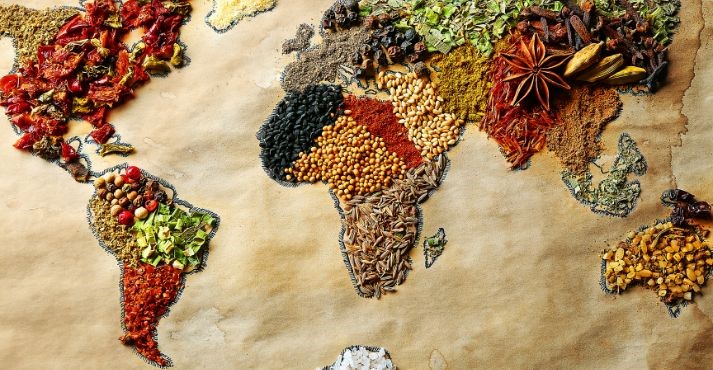
As we look into the regional market insights, Saffron production by country has increased and is further poised with rising demands from worldwide consumer and industrial use.
Asia Pacific dominates the saffron market and is expected to grow during the forecast period, with India being a key country in saffron cultivation, trade, and consumption.
Saffron is the most popular food in Asia for culinary and industrial use. Saffron has also been used as a fabric dye, perfume, and food, particularly in China and India.
In Persian cuisine, Saffron is used in both savory and sweet dishes. The growing awareness of saffron’s medicinal properties ensures sustained saffron market growth in Asia Pacific.
North America’s demand for saffron is fueled by growing awareness of its health benefits and diverse cooking, medicine, and beauty applications.
The United States, in particular, leads due to increased demand for natural remedies, with F&B companies promoting and highlighting its quality. The saffron market in North America is thriving, driven by health-conscious trends and expanding saffron uses.
Europe has a rich tradition of using saffron, especially in cooking, maintaining its top position in the global exquisite food experiences. Spain, a significant player, grows high-quality saffron with strict regulations and a geographical indication, enhancing its market dominance.
The European saffron market is leaning towards organic food and premium variants, attracting luxury markets. Saffron’s inclusion in diverse European cuisines strengthens its market influence, highlighting the region’s contribution to saffron market growth and innovation.
Saffron Market Key Players
The competitive landscape of the saffron market is shaped by numerous factors, showcasing the dynamic and diverse nature of the industry.
Innovation, sustainable practices, and advanced processing techniques drive competition. Key players in the saffron market are actively implementing innovative strategies to stay ahead.
They focus on sustainable cultivation methods, ensuring ethical sourcing and environmental responsibility. Emphasis on research and development allows companies to introduce new saffron-based products, meeting consumers’ evolving preferences.
The global Saffron market is expected to grow, with increased production using indoor farming methods and rising demands for organic Saffron remaining the critical focus.
The extensive distribution of saffron production in different regions markedly impacts the level of competition within the sector. The leading Saffron producers in the world are:
- Safrante Global Company S.L.U.
- Evolva
- Rowhani Saffron Co
- Sara Nuts
- Tarvand Saffron Co
- Hijos de Eustaquio Abad & Co. S.L.
- USMS Saffron Co. Inc.
- Royal Saffron Company
- Saharkhiz International Group Companies
- Gohar Saffron
- Novin Saffron Co.
- Azafranes Manchegos SL
Conclusion
Saffron, renowned for its vibrant color and distinct flavor, stands out as one of the world’s most expensive spices due to its meticulous hand-picking process and limited availability.
As the industry adjusts to these changing dynamics, achieving a balance between supply and demand, the emerging trends become essential in shaping the future of saffron.
The Saffron market exhibits dynamic growth driven by shifting consumer preferences, cultural influences, and expanding applications. The market’s popularity continues to soar, fueled by increasing consumer demand for natural ingredients and awareness of saffron’s health benefits.
Its versatile applications in culinary, pharmaceuticals, and cosmetics contribute to its competitiveness due to the rising preference for natural and premium ingredients. The growth is further propelled by saffron’s unique flavor profile and integration into traditional cuisines globally.
Key players focus on innovation and sustainability, contributing to the industry’s competitive landscape. As the saffron industry evolves to meet diverse demands, its prominence in various sectors signifies a promising future driven by consumer choices and the spice’s intrinsic value.





























